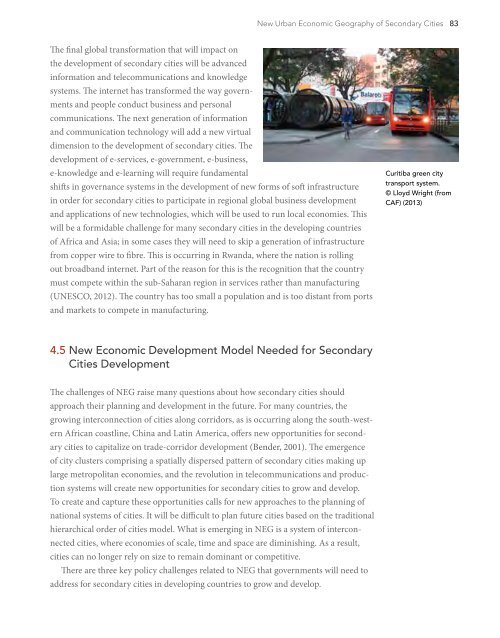DYhWN
DYhWN
DYhWN
You also want an ePaper? Increase the reach of your titles
YUMPU automatically turns print PDFs into web optimized ePapers that Google loves.
New Urban Economic Geography of Secondary Cities 83The final global transformation that will impact onthe development of secondary cities will be advancedinformation and telecommunications and knowledgesystems. The internet has transformed the way governmentsand people conduct business and personalcommunications. The next generation of informationand communication technology will add a new virtualdimension to the development of secondary cities. Thedevelopment of e-services, e-government, e-business,e-knowledge and e-learning will require fundamentalshifts in governance systems in the development of new forms of soft infrastructurein order for secondary cities to participate in regional global business developmentand applications of new technologies, which will be used to run local economies. Thiswill be a formidable challenge for many secondary cities in the developing countriesof Africa and Asia; in some cases they will need to skip a generation of infrastructurefrom copper wire to fibre. This is occurring in Rwanda, where the nation is rollingout broadband internet. Part of the reason for this is the recognition that the countrymust compete within the sub-Saharan region in services rather than manufacturing(UNESCO, 2012). The country has too small a population and is too distant from portsand markets to compete in manufacturing.Curitiba green citytransport system.© Lloyd Wright (fromCAF) (2013)4.5 New Economic Development Model Needed for SecondaryCities DevelopmentThe challenges of NEG raise many questions about how secondary cities shouldapproach their planning and development in the future. For many countries, thegrowing interconnection of cities along corridors, as is occurring along the south-westernAfrican coastline, China and Latin America, offers new opportunities for secondarycities to capitalize on trade-corridor development (Bender, 2001). The emergenceof city clusters comprising a spatially dispersed pattern of secondary cities making uplarge metropolitan economies, and the revolution in telecommunications and productionsystems will create new opportunities for secondary cities to grow and develop.To create and capture these opportunities calls for new approaches to the planning ofnational systems of cities. It will be difficult to plan future cities based on the traditionalhierarchical order of cities model. What is emerging in NEG is a system of interconnectedcities, where economies of scale, time and space are diminishing. As a result,cities can no longer rely on size to remain dominant or competitive.There are three key policy challenges related to NEG that governments will need toaddress for secondary cities in developing countries to grow and develop.


